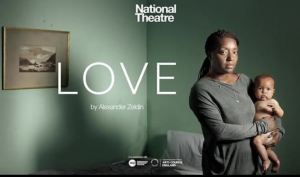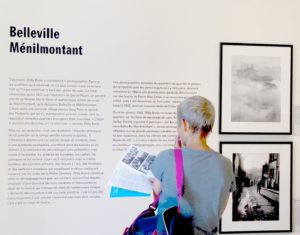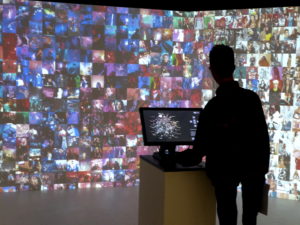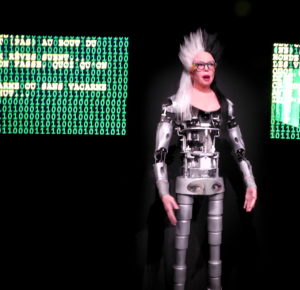 Nadar—the world’s first celebrity photographer—was Felix Tournachon’s nom de plume which he started using as a caricaturist, journalist and novelist before shifting to photography and making portraits of such celebrated Parisians as Charles Baudelaire, Gustave Doré and Sarah Bernhardt. The exhibition “Les Nadar, une legende photographique” at the National Library of France (BNF) displays the work of Felix Tournachon (1820-1910) and photographs by his less-known brother Adrien (1825-1903) and his son Paul (1856-1939). Continue reading “Les Nadar… A French Family Affair”
Nadar—the world’s first celebrity photographer—was Felix Tournachon’s nom de plume which he started using as a caricaturist, journalist and novelist before shifting to photography and making portraits of such celebrated Parisians as Charles Baudelaire, Gustave Doré and Sarah Bernhardt. The exhibition “Les Nadar, une legende photographique” at the National Library of France (BNF) displays the work of Felix Tournachon (1820-1910) and photographs by his less-known brother Adrien (1825-1903) and his son Paul (1856-1939). Continue reading “Les Nadar… A French Family Affair”
Politics of Seeing

Paris’ Jeu de Paume revisits the work of documentary photographer Dorothea Lange with a major retrospective “Dorothea Lange, Politics of Seeing” (until January 27, 2019). The exhibition originated at the Oakland Museum of California —home of the photographer’s archives— donated to the museum fifty years ago by her husband and collaborator Paul Shuster Taylor. Continue reading “Politics of Seeing”
Surveillé-e-s

Following his denial of access by Google, artist John Gerrard hired a helicopter and produced a detailed photographic survey of one of the key physical sites of the internet, a Google data server building in Oklahoma known as a “data farm.” This survey was the starting point for “Farm (Pryor Creek, Oklahoma)” featuring a slow pan portrait of a simulated “twin” of the squat building flanked by diesel generators and powerful cooling towers. Continue reading “Surveillé-e-s”
Alexander Zeldin’s Love Story
 This love story has nothing to do with the 1970 film starring Ali MacGraw. Instead we fast forward to the present where we find several people cramped together during the Christmas holidays in a homeless shelter. With Zeldin’s play (In Paris, November 5-10, 2018) love is the common denominator and a last ditch form of resistance. Continue reading “Alexander Zeldin’s Love Story”
This love story has nothing to do with the 1970 film starring Ali MacGraw. Instead we fast forward to the present where we find several people cramped together during the Christmas holidays in a homeless shelter. With Zeldin’s play (In Paris, November 5-10, 2018) love is the common denominator and a last ditch form of resistance. Continue reading “Alexander Zeldin’s Love Story”
Willy Ronis Revisited
 Black and white photography fans remember Willy Ronis (1910-2009) for his lyric post war photographs depicting working class Parisians of the Belleville and Ménilmontant neighborhoods. His photo book “Belleville Ménilmontant” is a beloved classic. Now, nearly a decade after his death, Ronis’ photographs are being exhibited back in Paris’ 20th arrondissement where many of the pictures were originally taken (at the Pavillon Carré de Baudouin until January 02, 2019). Continue reading “Willy Ronis Revisited”
Black and white photography fans remember Willy Ronis (1910-2009) for his lyric post war photographs depicting working class Parisians of the Belleville and Ménilmontant neighborhoods. His photo book “Belleville Ménilmontant” is a beloved classic. Now, nearly a decade after his death, Ronis’ photographs are being exhibited back in Paris’ 20th arrondissement where many of the pictures were originally taken (at the Pavillon Carré de Baudouin until January 02, 2019). Continue reading “Willy Ronis Revisited”
Paris Exhibition Explores Data Visualization

With the Cambridge Analytica scandal one might not be in the mood for seeing an exhibition about visualizing data while visiting Paris, but the “123 data” exhibition at the Fondation EDF is a “smiley face” showing what creators are doing with data. The exhibition is both fun and informative while making the argument that data is not just a threat to our private lives and means to enrich powerful corporations, but also a source of inspiration for artists. Continue reading “Paris Exhibition Explores Data Visualization”
Can My Kid Cope with French Schools?
 Q: I am moving from the States to Paris in the fall with my 6-year-old son who will attend a French public school. Since he doesn’t speak any French I worry that he’ll be traumatized when he realizes he can neither understand a thing, nor make himself understood. How can I make the transition easier for him? A: Children learn languages faster than their parents. They are far less self-conscious about making mistakes than adults are, and make frequent use of body language that is pretty much similar across cultures. Still, to help the process along, here are a few suggestions. Continue reading “Can My Kid Cope with French Schools?”
Q: I am moving from the States to Paris in the fall with my 6-year-old son who will attend a French public school. Since he doesn’t speak any French I worry that he’ll be traumatized when he realizes he can neither understand a thing, nor make himself understood. How can I make the transition easier for him? A: Children learn languages faster than their parents. They are far less self-conscious about making mistakes than adults are, and make frequent use of body language that is pretty much similar across cultures. Still, to help the process along, here are a few suggestions. Continue reading “Can My Kid Cope with French Schools?”
Roman Cieslewicz Retrospective

“I wanted to leave Poland to see how my posters would stand up to the neon light of the west. I dreamed of Paris.” Roman Cieslewicz (1930-1996) came to Paris in 1963 and quickly became one of France’s leading graphic artists. The Musée des Arts Décoratifs revisits this major figure in late 20th century graphic design with a retrospective Roman Cieslewicz, la fabrique des images (until Sept. 23, 2018).
“Morel’s Invention” Paris Exhibition

Paris’ Maison de l’Amérique Latine hosts an exhibition by fifteen international artists—photos, installations, holograms, video projections— inspired by Argentinian writer Adolfo Bioy Casares’ science fiction novel “Morel’s Invention or The Image Machine,” published in 1940 (to July 21, 2018). The book—a contemplation of image, reality, immortality and love— has influenced generations of artists from Garcia Marquez to Robbe-Grillet’s scenario for “L’Année Derniere à Marienbad (1961). Continue reading ““Morel’s Invention” Paris Exhibition”
Henrik Saxgren “Ultima Thule”

Paris’ Denmark House is showing Henrik Saxgren’s stunning documentary photographs of Arctic Greenland (to May 17, 2018). Saxgren’s photos depict the life of sea hunters in the northernmost Greenlandic settlements. Documenting life in the harsh arctic wilderness he accompanied them on hunts on sea ice and travelled hundreds of miles by dog sled. The result is his latest book “Ultima Thule” and the exhibition at the Danish cultural center. Continue reading “Henrik Saxgren “Ultima Thule””
Robots & Artists at Grand Palais

Art meets technology with “Artistes & Robots” at the Grand Palais (until July 9). The exhibition, featuring mostly European artists, opens with Jean Tinguely’s mid-1950s “Metamatics” (machines that make paintings). Among the techno pioneers the exhibition includes Nam June Paik’s iconic pseudo robot, “Olympe de Gougs,” an assembly of 12 wooden television sets, 12 color monitors and a laser videodisc player. It was commissioned by Paris for the bicentenary of the French Revolution in 1989. Continue reading “Robots & Artists at Grand Palais”

